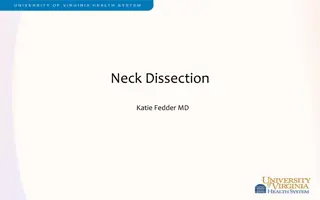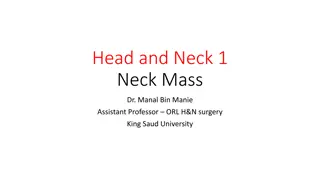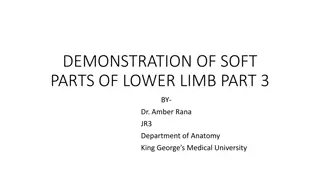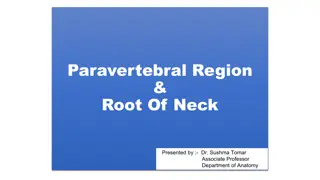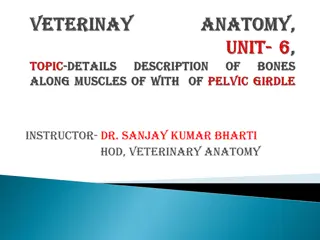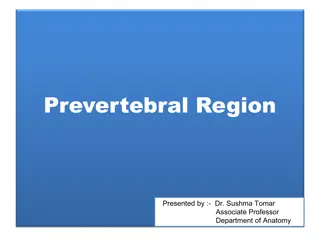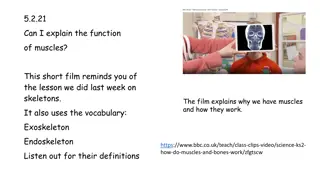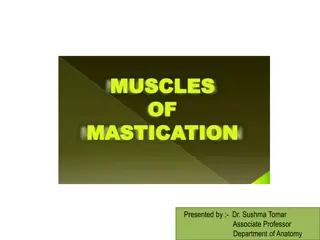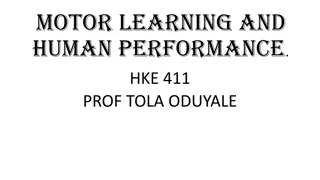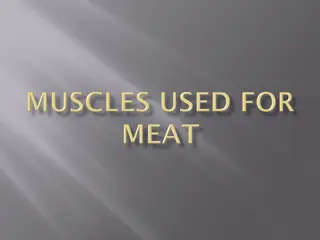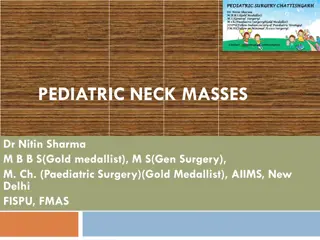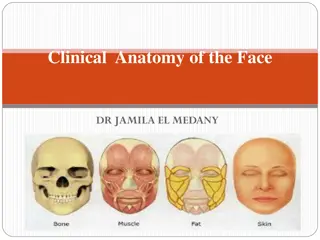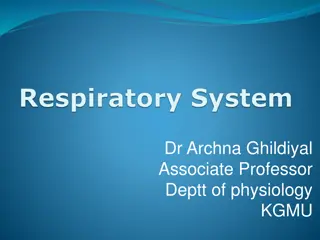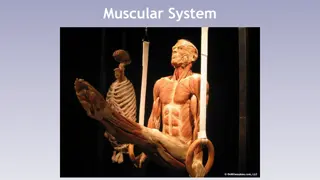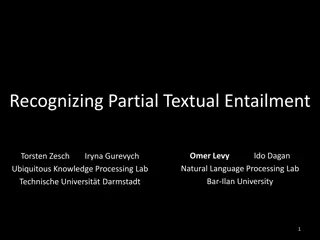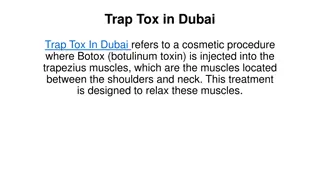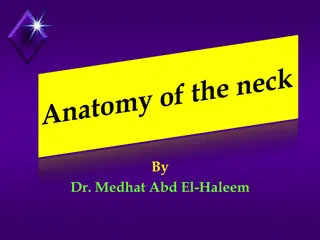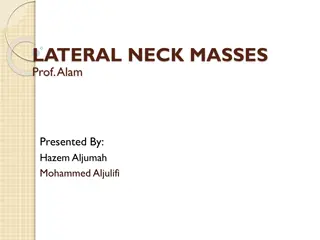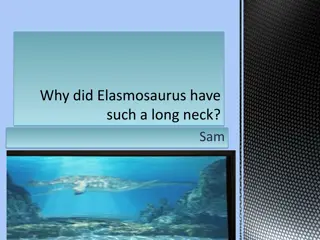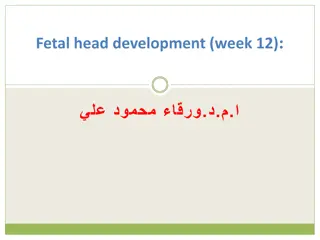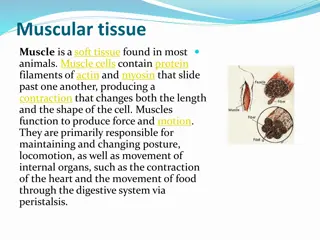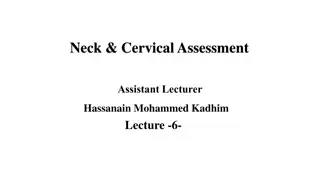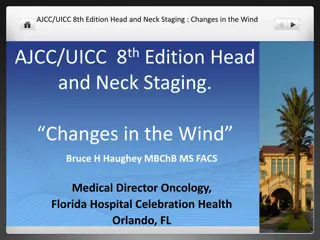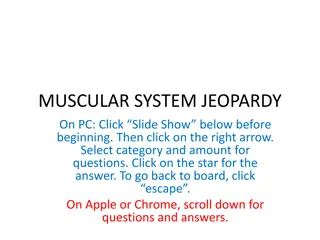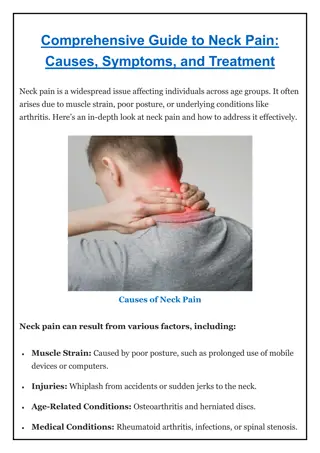The muscular system
The muscular system is a vital organ system that includes smooth, skeletal, and cardiac muscles. It plays a crucial role in locomotion, supporting the cardiovascular system, enabling lung ventilation, regulating fluids, maintaining posture, and generating heat in the body. This system consists of ar
2 views • 16 slides
Overview of Neck Dissection in Head and Neck Cancer
Neck dissection is a crucial procedure for the prognostic and therapeutic management of head and neck cancers, particularly in cases where cancer has spread to the cervical lymph nodes. This process involves removing all lymph nodes and surrounding structures in the neck region to prevent the spread
8 views • 25 slides
Understanding Kinesiology Taping Techniques and Benefits
Kinesiology taping is a technique utilizing thin, flexible tape to relieve pain, reduce swelling, and provide support to muscles and joints. Introduced by Dr. Kenzo Kase in the 1970s, it includes techniques such as muscle, ligament, fascial, correction, lymphatic drainage, and functional movement te
8 views • 14 slides
Do you want relief from Neck Pain in South Brisbane
Do you want relief from Neck Pain in South Brisbane? Then contact Innervate Chiro. Their dedicated practitioners combine their experience in Chiropractic, Remedial & Sports Massage for fast effective relief of Back Pain, Neck Pain, Headaches, Vertigo, Sports Injuries, shoulder, hip, nerve pain, scia
0 views • 6 slides
Understanding Neck Anatomy: Triangles, Glands, and Lymph Nodes
Explore the intricate anatomy of the neck, including the various triangles, thyroid and parotid gland structures, as well as cervical lymph nodes. Delve into the essentials of neck mass evaluation, differential diagnosis, and management strategies. Enhance your knowledge of head and neck surgery thr
0 views • 53 slides
Demonstration of Soft Parts of Lower Limb - Part 3 by Dr. Amber Rana at King George's Medical University
This presentation outlines the structures of the lateral compartment of the leg, posterior compartment of the leg, and dorsum of the foot. It includes information on boundaries, muscles, nerves, and vessels in each region, along with detailed descriptions of specific structures such as the peroneus
0 views • 15 slides
Animal Muscle Identification and Anatomy Diagrams
This collection includes detailed diagrams showcasing the identification and anatomy of muscles in animals, specifically focusing on pig muscle anatomy. From head and neck muscles to arm and shoulder muscles, pelvis and thigh muscles, and trunk muscles, these visual aids help understand the structur
3 views • 26 slides
Demonstration of Lower Limb Soft Tissues - Part 3
This detailed demonstration by Dr. Amber Rana from King George's Medical University focuses on identifying and describing the structures of the lateral compartment of the leg, posterior compartment of the leg, and dorsum of the foot. It covers boundaries, muscles, nerves, and vessels present in each
0 views • 15 slides
Anatomy of Paravertebral Region and Root of Neck
This informative content presents the paravertebral region and the muscles of the neck, including the scalene muscles (posterior, medius, and anterior). It covers the origin, insertion, nerve supply, and actions of these muscles, providing a clear understanding of their functions. Additionally, it d
0 views • 18 slides
Understanding Pelvic Limb Anatomy: Bones and Muscles Overview
Bones and muscles of the pelvic limb, including the pelvis, thigh, leg, and foot, are detailed in this informative content. It covers the general designations of pelvic bones, descriptions of bones along with muscle attachments in various animals, and specifics about the hip bone structure and forma
1 views • 15 slides
Understanding the Intrinsic Muscles of the Tongue - Anatomy and Physiology Overview
In this detailed presentation by Dr. Sushma Tomar, Associate Professor of Anatomy, the intrinsic muscles of the tongue are explored, along with their functions, arterial and venous supply, lymphatic drainage, and nerve supply. The lecture covers the four intrinsic muscles in each half of the tongue,
1 views • 15 slides
Anatomy of the Prevertebral Region in the Neck
The prevertebral region in the neck extends from the 1st cervical vertebra to the upper two thoracic vertebrae. It includes structures like prevertebral and paravertebral muscles, cervical plexus, sympathetic chains, and large vessels. The prevertebral muscles, including rectus capitis anterior and
0 views • 15 slides
Understanding the Function of Muscles - Our Amazing Muscular System
Our muscles play a vital role in our bodies by helping us move, pump blood, digest food, and breathe. They are made up of muscle fibers and connected to bones by tendons. The muscles work by contracting and relaxing when we move. To keep our muscles healthy, it's important to engage in physical acti
0 views • 6 slides
Understanding the Histological Structure of Muscle Cells
This presentation delves into the histological structure of three types of muscle cells - skeletal, cardiac, and smooth muscles. Learn about their differences, such as striation, voluntary vs. involuntary control, and cellular organization. Discover the components of muscular tissue, the coverings o
0 views • 13 slides
Overview of Muscles of Mastication in Anatomy
This presentation by Dr. Sushma Tomar provides detailed information on the principal and accessory muscles of mastication, focusing on the Masseter and Temporalis muscles. It covers their origins, insertions, nerve supplies, actions, and applied aspects like trismus. The content is accompanied by im
0 views • 20 slides
Understanding the Biological Basis of Human Motion and Motor Learning
In the biological basis of human motion, a series of electro-chemical-physical reactions occur at the neuromuscular junction, enabling nerve stimulation for muscle contraction. Nerve impulses for movement originate in the central nervous system or muscles, with acetylcholine transmitting impulses be
0 views • 13 slides
Identifying Tender, Intermediate, and Tough Muscles in Various Steaks
Explore the classification of muscles into tender, intermediate, and tough categories in different cuts of meat. Specific muscles such as Psoas major, Longissimus dorsi, Gluteus medius, Multifidus dorsi, Biceps femoris, and more are highlighted in different steaks, revealing the varying textures and
0 views • 11 slides
Pediatric Neck Masses: Causes and Anatomy Explained by Dr. Nitin Sharma
Learn about pediatric neck masses, their causes including congenital, inflammatory, and malignant factors, and the embryology and anatomy behind them. Detailed insights are provided on the branchial system, its arches, pouches, and the structures they contribute to in the neck. Dr. Nitin Sharma, a h
0 views • 42 slides
Understanding Neck Swellings and Cysts
Explore the anatomy of neck muscles, main categories of neck swellings, and different types of cysts like ranula, dermoid cyst, and thyro-glossal cyst. Learn about their characteristics, locations, and treatment options. Visual aids included.
0 views • 74 slides
Clinical Anatomy and Muscles of the Face Explained
Detailed information on the clinical anatomy of the face, covering the skin's criteria, skin tension lines, muscles of facial expression, muscles acting on the forehead, muscles of the eyelids, and muscles of the mouth. Understand the structure, function, and importance of each component in facial a
0 views • 34 slides
Clinical Evaluation of Trigeminal Nerve Function
Sensory evaluation of trigeminal nerve function involves assessing exteroceptive sensations across its divisions, identifying sensory losses due to lesions, and distinguishing different types of lesions affecting sensation on the face. Motor evaluation focuses on the muscles of mastication to detect
0 views • 34 slides
Exploring Stretchiness: From Human Muscles to Rubber and Snakes
Learn about the fascinating world of stretchiness, from the elastic properties of human muscles containing the protein TITIN to the unique characteristics of rubber, snakes, and even the iconic Stretch Armstrong doll. Discover why some materials can stretch while others cannot, delving into the scie
1 views • 9 slides
Comprehensive Adult and Pediatric HEENT, Neck, and Cranial Nerves Examination Guide
This comprehensive guide outlines the components of a normal HEENT, neck, and cranial nerves examination for adults and pediatric patients, including identifying abnormal findings and conducting focused exams. It covers common or concerning symptoms related to the head, eyes, ears, nose, oropharynx,
0 views • 77 slides
Mechanics of Pulmonary Ventilation and Respiratory Cycle Explained
Understanding the mechanics of pulmonary ventilation is crucial for comprehending the breathing process. This comprehensive overview covers the role of muscles, ribs, pressure changes in alveolar, pleural, and transpulmonary regions, terms related to breathing and ventilation, and the contraction an
0 views • 31 slides
Understanding the Thoracic Cage and Respiratory Movements in Anatomy Lecture
Professor Ahmed Fathalla Ibrahim, a renowned Professor of Anatomy at King Saud University, covers the components of the thoracic cage, articulations, respiratory movements, and muscles involved in breathing in this informative lecture. Learn about the structure of the thoracic cage, articulations li
0 views • 24 slides
Understanding the Muscular System and Its Anatomy
The muscular system is vital for movement, posture maintenance, and organ protection. It consists of skeletal muscles that contract to create movement, circular muscles called sphincters for controlling openings, and muscle fibers arranged in fascicles with collagen layers like epimysium and endomys
0 views • 59 slides
Monitoring Thyroid Function After Head and Neck Cancer Treatment
This collection of images and data discusses the importance of monitoring thyroid function after head and neck cancer treatment, specifically focusing on post-treatment thyroid function tests, audits of practices in head and neck units, thyroid function post laryngectomy, and the significance of det
0 views • 11 slides
Understanding Textual Entailment in Natural Language Processing
This collection of images showcases various aspects of textual entailment, where one text can entail another. It explores the relationship between statements like "muscles move bones" and "muscles generate movement". Different levels of entailment are depicted, culminating in complete textual entail
0 views • 72 slides
Trap Tox in Dubai.pptx
Trap Tox refers to a cosmetic procedure where Botox (botulinum toxin) is injected into the trapezius muscles, which are the muscles located between the shoulders and neck. This treatment is designed to relax these muscles.
4 views • 5 slides
Understanding the Triangles of the Neck
The neck is divided into various triangular areas by muscles such as the sternomastoid muscle. These triangles play important roles in anatomy, with the investing layer of deep fascia roofing them. Moreover, muscles like the omohyoid and sternomastoid have specific origins and actions in the neck re
0 views • 23 slides
Understanding Lateral Neck Masses: Anatomy, Diagnosis, and Management
Explore the anatomy and lymphatic drainage of the neck to effectively approach and differentiate various lateral neck masses. Learn about the anterior and posterior triangles of the neck, common neck mass differentials, and the significance of lymph nodes in neck pathology.
0 views • 65 slides
Clinical Audit of Dental Screening in Head and Neck Oncology Patients
This clinical audit focuses on evaluating the quality of dental screening and preventative management, including fluoride prescriptions, in head and neck oncology patients. The aim is to assess if the screenings meet best practice guidelines, with objectives related to dental screenings, OPG radiogr
0 views • 15 slides
Why did Elasmosaurus Have Such a Long Neck?
Elasmosaurus had a long neck to stretch and catch food easily. Its neck could measure up to 13 meters, half of its total length, which could be up to 26 meters. With a length of up to 40 feet, Elasmosaurus would use its long neck to attack Pteranodon while hunting for fish. Despite some speculations
0 views • 6 slides
Development of Fetal Head and Neck Structures in Week 12
The fetal head and neck structures in week 12 exhibit a complex formation process involving contributions from all three embryonic layers and the neural crest. Neural crest plays a significant role in developing jaw skeletal elements, connective tissues, and tendons. The pharynx, starting at the buc
0 views • 30 slides
Understanding Muscle Tissue: Structure and Function
Muscle tissue is a vital component in most animals, facilitating movement and maintaining posture. Derived from embryonic cells, muscles come in three types: skeletal, cardiac, and smooth, each serving specific functions in the body. While skeletal muscles are under voluntary control, cardiac and sm
0 views • 15 slides
Comprehensive Guide to Neck and Cervical Assessment by Hassanain Mohammed Kadhim
Learn how to inspect the neck for appearance and movement, differentiate between normal and abnormal findings, and perform palpation techniques for the trachea, thyroid gland, and cervical lymph nodes. Discover the important landmarks and characteristics to assess during a neck examination.
0 views • 13 slides
AJCC/UICC 8th Edition Head and Neck Staging Changes
This content delves into the changes in staging guidelines for head and neck malignancies as per the 8th edition of the AJCC/UICC criteria. It explores the modifications in staging for oropharynx cancer, neck metastatic disease, oral cavity depth of invasion, and cutaneous malignancies. The presenta
0 views • 32 slides
Muscles of the Anterior and Medial Thigh Anatomy Overview
Explore the anatomy of the muscles in the anterior and medial compartments of the thigh, covering origins, insertions, nerve supplies, and actions. Learn about the divisions, compartments, and common muscles responsible for knee extension and hip flexion. Discover the structures of the femoral trian
0 views • 18 slides
Muscular System Jeopardy - Learn About Muscle Functions and Facts
Explore the Muscular System Jeopardy game to understand how muscles work, muscle group names, exercises to build muscles, and the importance of healthy muscles. Discover interesting facts about muscle function, including how messages from the brain trigger muscle contractions, the role of tendons in
0 views • 52 slides
Comprehensive Guide to Neck Pain - Hind Spine Clinic
Discover a comprehensive guide to neck pain at Hind Spine Clinic. Learn about the causes, symptoms, and effective treatments for neck pain, from posture correction to advanced therapies. Our expert team provides personalized care to help you relieve
2 views • 4 slides

